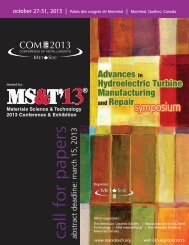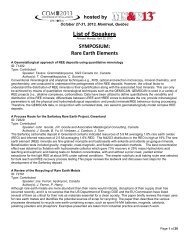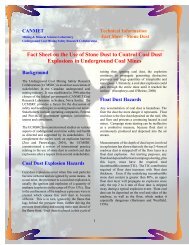List of Speakers SYMPOSIUM: Light Metals for Transportation
List of Speakers SYMPOSIUM: Light Metals for Transportation
List of Speakers SYMPOSIUM: Light Metals for Transportation
Create successful ePaper yourself
Turn your PDF publications into a flip-book with our unique Google optimized e-Paper software.
hosted byOctober 27-31, 2013, Montreal, Quebec<strong>List</strong> <strong>of</strong> <strong>Speakers</strong>Revised: Monday, April 22, 2013<strong>SYMPOSIUM</strong>:<strong>Light</strong> <strong>Metals</strong> <strong>for</strong> <strong>Transportation</strong>Pot-To-Pot Busbars Thermoelectric ModelID: 72282Type: ContributedSpeaker: Sébastien Guérard, Rio Tinto Alcan, CanadaAuthor(s): S. Guérard, D. OuillonBusbars are used in the aluminum reduction technology to carry current from the cathodic bars <strong>of</strong> a cell to the anodicassembly <strong>of</strong> the next one. The electric and thermal per<strong>for</strong>mances <strong>of</strong> these conductors are essential to the smelteroperations.In this work, a thermoelectric finite model <strong>of</strong> the AP3X and AP6X conductors is presented. The model canrepresent both normal and bypassed configurations, with no limits to the number <strong>of</strong> pots considered. It is also fullyparameterized, allowing the inclusion or exclusion <strong>of</strong> the risers, anode beam, cathodes, equipotential wedges, auxiliarybridges, and radiative impact <strong>of</strong> the nearby shells.The model can be used to assist in amperage creep project, to gaininsight into the operation <strong>of</strong> the busbars, to assess potential scenarios, and to help consider alternative designs. It hasbeen extensively validated based on experimental measurements from several plants.Practical Use <strong>of</strong> Fluid Flow and Solidification Modeling in the Shape Casting <strong>of</strong> <strong>Light</strong> <strong>Metals</strong>ID: 70005Type: ContributedSpeaker: Franco Chiesa, Centre de Métallurgie du Québec (CMQ), CanadaAuthor(s): F. Chiesa, N. Giguère, B. TougasIf fluid flow and heat transfer modeling are now a must in any advanced research where these physical phenomena are atplay, they may also be used to solve very practical quality problems in shape casting foundries. User friendly commercials<strong>of</strong>twares are now available at a price accessible even to small foundries. Two case studies will show how fillingsimulations helped overcome the difficulty in filling thin wall magnesium and aluminium castings poured in sand and lowpressure permanent molds. Solidification modeling is a very potent tool <strong>for</strong> the prediction <strong>of</strong> internal shrinkage defects aswill be demonstrated on a magnesium automotive LPPM poured bell housing and on an investment cast titaniumvalve.Modeling can also be used to predict the realistic level <strong>of</strong> quality achievable by a given process as will be shown onan aluminum sand casting subjected to the ASTM B686 standard <strong>of</strong> quality.Primary Aluminum Processing in Quebec and CanadaID: 74087Type: InvitedSpeaker: , ,Author(s): R. HarriesThe presentation covers various aspects in the development <strong>of</strong> primary aluminium processing in Quebec and CanadaQuantification <strong>of</strong> Primary and Eutectic Undercoolings <strong>of</strong> Impulse Atomized Al-Cu DropletsID: 70856Type: ContributedSpeaker: Abdoul-Aziz Bogno, University <strong>of</strong> Alberta, CanadaAuthor(s): A. Bogno, P. Delshad Khatibi, H. Henein, C. GandinRapid solidification undercooling <strong>of</strong> alloys results in microstructures with reduced microsegregation. Indeed, themetastable extension <strong>of</strong> solute solubility yields materials with relatively low fraction <strong>of</strong> eutectic structure. This paperreports on the quantification <strong>of</strong> primary and eutectic undercoolings resulting from rapid solidification <strong>of</strong> Al-Cu droplets <strong>of</strong>different sizes and compositions obtained by Impulse Atomization. Previous work by some <strong>of</strong> the authors <strong>of</strong> this studyPage 12 <strong>of</strong> 17


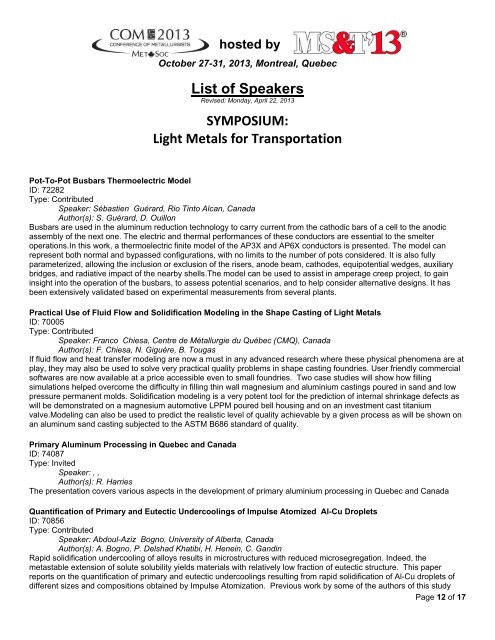

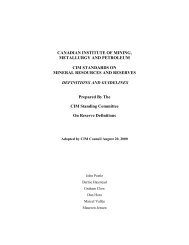
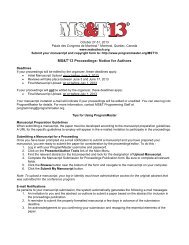


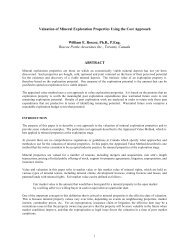
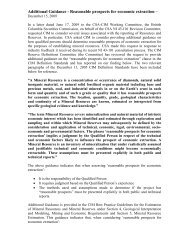
![Richard Wright - NORWEST Corporation [PDF]](https://img.yumpu.com/34320526/1/190x245/richard-wright-norwest-corporation-pdf.jpg?quality=85)
